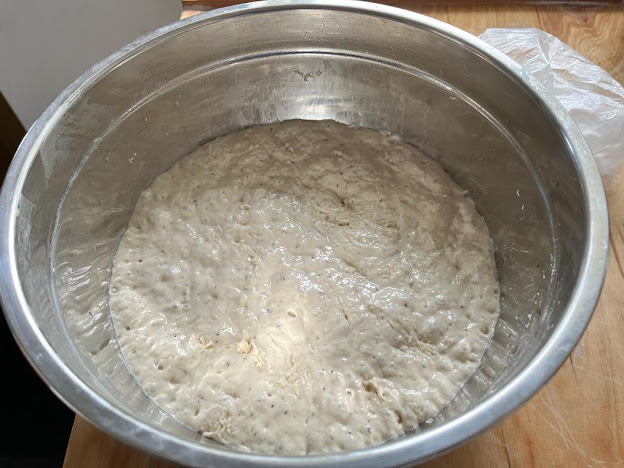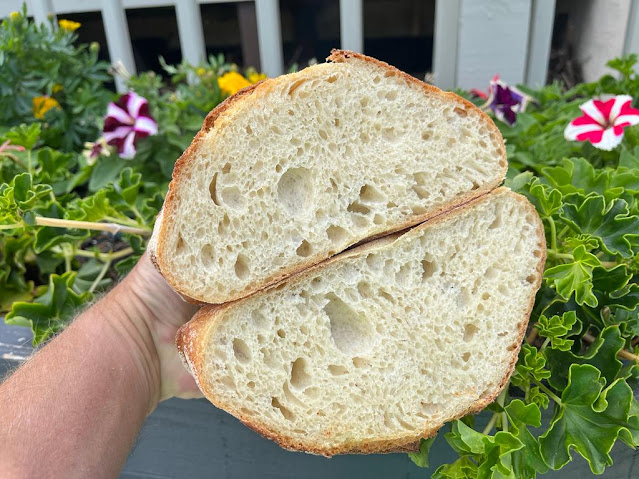Jim Lahey's No-Knead Bread
Jim Lahey started out as an art student in Italy. On returning to New York, with every intention of becoming a sculptor, he was downhearted at not being able to find bread in the Big Apple of the same quality as he could easily buy in Rome.
In 1994, he opened the Sullivan Street Bakery and produced Italian-quality bread for the New Yorkers. He now has a pizzeria and cafe in Chelsea, a bakery in Miami and is the author of a number of influential books on bread and baking.
Lahey's no-knead bread method turned traditional bread making principles on its head. His method owes much to the Pain à l'Ancienne tradition of long fermentation; but, whereas that method relies on cold fermentation, Lahey's no-knead approach relies on long fermentation at room temperature.
The principle is simple: mix everything together, leave it alone for long enough and then bake it.
In Breadsong by Kitty and Alex Tait (2022), you will discover that it was Jim Lahey's recipe that sparked young Kitty Tait into recovery and set her and her father, Alex, on the road to opening their Orange Bakery in Walington, Oxfordshire, England.
FORMULA
400 gms strong white bread flour
300 gms room temperature water (I use filtered water)
8 gms crushed sea salt
2 gm of instant yeast (yes, you've read it correctly....2 gm)
You'll also need a heavy casserole, Pyrex casserole, Dutch Oven or enamelled roaster. Failing that, a baking tray or pizza stone and a metal bowl that can be used as a lid.
METHOD
Mix the flour, yeast and salt together in a large bowl.
Add the water and mix until everything is incorporated. Clean off the edges of the bowl with a spatula, so as not to waste any of the mixture. This should take no more than 30 seconds.
You will end up with a shaggy, sticky dough. That's perfect!
Cover the bowl with a plate or plastic wrap, a towel or a shower cap - anything to ensure that you keep the moisture in and the flies out.
Set it aside at room temperature for at least 12 hours and up to 20 hours.
When you see that the dough has fermented properly - it will have grown in size, the top will be bubbly, it will jiggle a little and the top will be slightly domed.
If it is, it's ready....if it's not, leave it until it is.
Long, slow fermentation produces the bread's rich flavour
Next.....
Flour a work surface.
Turn the dough out onto the floured surface and gently lift the edges of the dough into the centre, folding the dough in on itself.
Tuck the edges in to make a boule but DON'T knead the dough.
Cut a piece of parchment paper and flour it.
Transfer the dough to the paper. Generously flour the surface of the loaf and then cover it with a tea towel or piece of cloth.
Leave at room temperature for up to 2 hours or so (Watch the dough....not the clock)
After about 90 minutes, preheat the oven and a heavy casserole, Dutch Oven, etc., to 230⁰C.
You'll know when it's ready because it will have doubled in size and when you gently poke a finger into the dough, it will hold the impression for a little while. If it doesn't, it needs a few more minutes.
Decision time! - you can bake the loaf seam-side up to avoid having to slash the dough, or you can slash it as you would a sourdough or, even more interestingly, you can leave it uncut and let the dough find its own weak point and open up where it wants to.
Transfer the dough to the pot and replace the lid.
Bake at 230⁰C for 30 minutes with the lid in place.
Remove the lid and continue to bake for 15 - 20 minutes more until it is golden brown and hollow when tapped underneath.
Cool on a rack for about an hour
Happy Baking





.jpeg)




Comments
Post a Comment